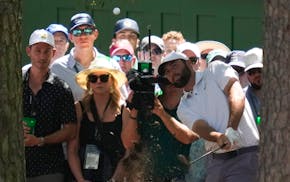DENVER - The Wild holds one obvious advantage in this series, even while facing elimination tonight: Minnesota employs the two toughest guys in the arena.
Enforcers Derek Boogaard and Chris Simon are not people you would want to meet in a dark alley or a neon arena, and their intimidating presence has raised a question about hockey enforcers that Wild management seems to have forgotten to ask:
What good are goons?
Even while ignoring a lack of depth at center and defense, the Wild, concerned about Boogaard's iffy back, went three-deep in one-dimensional players, picking up Todd Fedoruk off waivers and acquiring Simon at the trading deadline.
It's actually unfair to lump Fedoruk in with the other two, because he's been a pleasant surprise this season -- a tough guy who can actually play the game. Fedoruk has even played on the power play because of his willingness to muck it up in front of the net.
While Fedoruk has contributed hockey skills, Boogaard has mostly drawn penalties and lurked. He did make an impact in the first period Thursday, stalking the Avs on the forecheck, but he's more likely to take a bad penalty than make a good play.
Simon? The only damage he's doing in this series is to the press box nachos. He should get his named printed on his own personal chair, like a Hollywood director.
After watching the Anaheim Ducks manhandle his team in last year's playoffs, Wild GM Doug Risebrough wanted to make this year's team tougher. But the players who win playoff games are tough guys who can skate, make clean hits, maybe agitate the other team's scorers, draw penalties and actually capitalize on a scoring chance once in a while.
The Ducks won because they were a highly skilled team whose second and third lines consisted of players whose relentless physical play led to lots of time in the offensive zone and lots of gritty, playoff-style goals.
Ryan Getzlaf, Corey Perry, Dustin Penner, Sammy Pahlsson, Rob Niedermeyer, Travis Moen and Chris Kunitz gave the Ducks seven physical players on the top three lines, to complement finesse players Teemu Selanne and Andy McDonald.
Those seven didn't need to drop the gloves to land knockout blows.
The justification for employing goons is that their presence prevents the other team from picking on the Wild's best, and least physical, players.
Let's review how well that's worked:
• Last year Anaheim's Brad May sucker-punched Kim Johnsson, one of the Wild's best, and least physical, defensemen. Johnsson was lost for the series. May served a suspension but returned to help Anaheim win the Stanley Cup.
Boogaard threatened revenge, but it came in the next season, during a meaningless game, and May held his own in the fight.
So how exactly did Boogaard's "presence" help the Wild?
• In the last game of this year's regular season, Colorado's Ian Laperriere, a hard-nosed player who can actually play hockey, roughed up Wild star Marian Gaborik.
This year, the Wild was prepared for such agitation. This year, the Wild had Fedoruk, Boogaard and Simon cracking their knuckles in anticipation.
So what happened? Nothing. Laperriere is too smart to drop the gloves with a heavyweight, so he's still skating around making plays while Gaborik, whether this is coincidence or not, has done nothing in this series.
Can someone please explain how the Wild's "enforcers" cleaned up that mess?
Boogaard likes to complain about other teams' agitators, players who test the boundaries of acceptable hockey violence, trying to disrupt opposing stars and draw retaliatory penalties.
But agitators, however vilified by opponents, help their teams win games. Can we say that about Boogaard or Simon?
Jim Souhan can be heard Sundays from 10 a.m.-noon on AM-1500 KSTP. jsouhan@startribune.com

Souhan: Why Tiger Woods should keep swinging
Souhan: Scheffler wins Masters again, shows what makes him special
Morikawa falters in final round at Masters

Keeping up with the Joneses who helped design Augusta National's classic back nine


